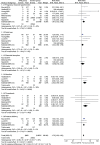Pregnancy outcomes in patients with primary antiphospholipid syndrome: A systematic review and meta-analysis
- PMID: 31096533
- PMCID: PMC6531250
- DOI: 10.1097/MD.0000000000015733
Pregnancy outcomes in patients with primary antiphospholipid syndrome: A systematic review and meta-analysis
Abstract
Background: Antiphospholipid syndrome (APS) is a rare heterogenous autoimmune disorder with severe life-threatening complications shown during pregnancy. In this analysis, we aimed to systematically compare the pregnancy outcomes (both maternal and fetal) in patients with APS.
Methods: Web of Science, Google Scholar, Medicus, Cochrane Central, Embase, and Medline were searched for relevant English publications. The main inclusion criteria were based on studies that compared pregnancy outcomes in patients with APS vs a control group. Statistical analysis was carried out by the RevMan software version 5.3. This analysis involved dichotomous data, and risk ratios (RR) with 95% confidence intervals (CIs) were used to represent the analysis.
Results: Eight studies consisting of a total number of 212,954 participants were included. Seven hundred seventy participants were pregnant women with APS and 212,184 participants were assigned to the control group. Pregnancy-induced hypertension was significantly higher in women with APS (RR: 1.81, 95% CI: 1.33 - 2.45; P = .0002). The risks of fetal loss (RR: 1.33, 95% CI: 1.00-1.76; P = .05), abortion (RR: 2.42, 95% CI: 1.46-4.01; P = .0006), thrombosis (RR: 2.83, 95% CI: 1.47-5.44; P = .002), and preterm delivery (RR: 1.89, 95% CI: 1.52-2.35; P = .00001) were also significantly higher in women with APS. However, placental abruption (RR: 1.35, 95% CI: 0.78-2.34; P = .29) and pulmonary embolism were not significantly different (RR: 1.47, 95% CI: 0.11-19.20; P = .77). The risk of neonatal mortality (RR: 3.95, 95% CI: 1.98-7.86; P = .0001), infants small for gestational age (RR: 1.38, 95% CI: 1.04-1.82; P = .02), premature infants (RR: 1.86, 95% CI: 1.52-2.28; P = .0001), and infants who were admitted to neonatal intensive care unit (RR: 3.35, 95% CI: 2.29-4.89; P = .00001) were also significantly higher in women with APS.
Conclusion: This analysis showed APS to be associated with significantly worse pregnancy outcomes when compared to the control group. A significantly higher risk of maternal and fetal complications was observed in this category of patients. Therefore, intense care should be given to pregnant women with APS to monitor unwanted outcomes and allow a successful pregnancy.
Figures






References
-
- Satta R, Biondi G. Antiphospholipid syndrome and pregnancy. G Ital Dermatol Venereol 2019;154:277–85. - PubMed
-
- De Carolis S, Tabacco S, Rizzo F, et al. Antiphospholipid syndrome: an update on risk factors for pregnancy outcome. Autoimmun Rev 2018;17:956–66. - PubMed
-
- Bundhun PK, Soogund MZ, Huang F. Impact of systemic lupus erythematosus on maternal and fetal outcomes following pregnancy: A meta-analysis of studies published between years 2001-2016. J Autoimmun 2017;79:17–27. - PubMed
-
- Wells GA, Shea B, O’Connell D, et al. The Newcastle-Ottawa scale (NOS) for assessing the quality if nonrandomized studies in meta-analyses. 2009. Available at: http://www.ohri.ca/programs/clinical_epidemiology/oxford.htm.
Publication types
MeSH terms
LinkOut - more resources
Full Text Sources
Medical
Miscellaneous

